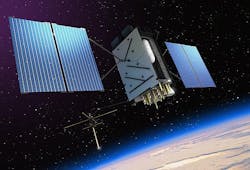Boeing to shrink, improve RF and microwave components for GPS digital waveform generator
KIRTLAND AIR FORCE BASE, N.M., 17 May 2016. U.S. Air Force researchers are asking engineers at the Boeing Co. to improve the performance and shrink the size of the digital waveform generator on Global Positioning System (GPS) satellites.
Officials of the Air Force, Air Force Research Laboratory (AFRL) Space Vehicles Directorate at Kirtland Air Force Base, N.M., announced a $16.2 million contract Monday to the Boeing Defense, Space & Security segment in El Segundo, Calif., for the On-Orbit Reprogrammable Digital Waveform Generator (ORDWG) for the GPS Spacecraft Navigation Payload program.
Boeing will advance the state-of-the art in signal generation, such as the Global Positioning System and other commercial and non-commercial position navigation and timing efforts, Air Force officials say. The ORDWG initiative is asking Boeing to build a new, improved, and smaller digital waveform generator for GPS satellites.
GPS waveform generators today are embedded in the mission data units (MDUs) of GPS satellites, and produce several codes that the satellites broadcast to navigation receivers on the ground, at sea, and in the air use to determine their positions, speeds, and direction of travel using triangulation.
The GPS satellite waveform generator drives the design and size, weight, power, and cost (SWaP-C) of the GPS L-band navigation payload as well as the host spacecraft bus, Air Force officials say.
Related: Northrop Grumman to shrink size of GPS satellite electronics with signal-generation upgrade
The Air Force is asking Boeing to increase the performance, flexibility, and affordability of the GPS payload by designing an improved digital waveform generator (DWG). The goal is to develop a space-qualified DWG able to replace those in current GPS satellite navigation payloads.
Boeing experts will design a more efficient, thermal- and radiation-tolerant reprogrammable DWG for existing GPS satellites, as well as for future enhancements that involve additional waveforms to the orbiting GPS constellation.
The basic architecture of reprogrammable digital waveform generator includes the reconfigurable processor, memory modules, power conversion and management, and monitoring and control. The focus of Boeing's effort is on the waveform generation section.
The inputs to the digital waveform generator are the elements of the GPS navigation message, synthesized reference frequency, code epoch synchronization, and control signals. The output is a low-power signal at the L1 GPS navigation frequency modulated with the appropriate navigation signals.
On this contract Boeing will do the work in Huntington Beach, Calif., and should be finished by January 2021. For more information contact Boeing Defense, Space & Security online at www.boeing.com/defense, or the Air Force Research Laboratory Space Vehicles Directorate at www.kirtland.af.mil/afrl_vs.

